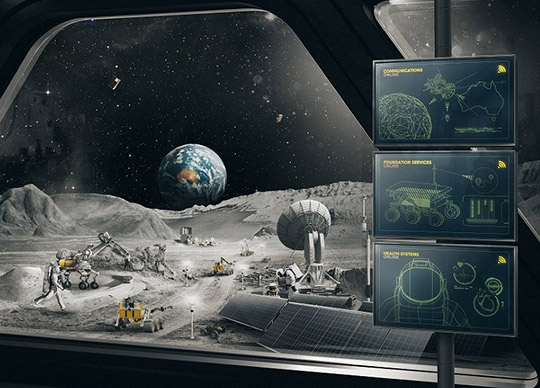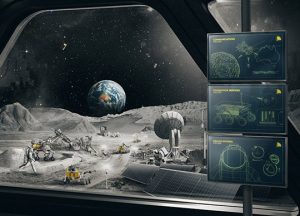

Image Credit: Australian Space Agency.
An AROSE study commissioned by the Australian Space Agency has confirmed for the first time that there is sufficient design and advanced manufacturing capability within Australia to build, test and operate a Lunar Services Rover in support of NASA’s return mission to the Moon.
Australia is a world-leader in technology and services for remote operations on Earth, and the study demonstrates there is a tangible pathway for that expertise to be applied in Space.
To undertake the study AROSE received funding through the Australian Space Agency’s Demonstrator Program, which provides opportunities for businesses and researchers to scope out the feasibility of projects which have the potential to operate or support operations in Space.
The grant led to AROSE securing additional funding and in-kind support from its members. AROSE also received sponsorships from IMDEX, South 32, OZ Minerals and the Western Australian Department of Jobs, Tourism, Science and Industry.
The project team for the study were First Mode, Fugro and Nova Systems, Woodside, MDA, Curtin University, The University of Western Australia, Queensland University of Technology and University of NSW.
Study Lead, Dr Sarah Cannard, from AROSE member Nova Systems, said the study identified more than 60 companies across Australia with the combined technology, services, facilities and workforce skills available, or under development, to design, manufacture, test and operate a Lunar Services Rover for NASA’s Artemis mission.
“The study confirms Australia has all the capabilities available either today or under development, to plan, build, test and operate the Lunar Services Rover,” Dr Cannard said. “Including the necessary components, sub-systems, testing and workforce skills.”
Rover sub-systems include navigation and control, excavation, regolith characterisation (sensors), on-board testing and computation, electronic power supply and ground communications.
AROSE CEO, Leanne Cunnold said it is an exciting time for Australia’s space industry with many opportunities for local companies to expand their service offering, develop workforce skills and become a valued part of the international Space supply chain.
“The Space sector is creating a new economic engine for growth and jobs in Australia,” Ms Cunnold said. “Companies can expand their industry focus to include Space and, perhaps for the first time, the next generation can look to the Space industry in Australia as a place to build a sustainable career at home.”
The study demonstrates Australia is ready to meet the challenges of the Australian Government’s Trailblazer Program. Under the program, a consortium of suitably qualified and experienced Australian companies will be chosen by the Australian Space Agency to design and develop a semi-autonomous rover for NASA’s Moon mission, planned to launch as early as 2026.
The Trailblazer Stage 1 tender to design and build the Lunar Services Rover was issued by the Australian Space Agency in December 2021 as part of the Federal Government’s $150 million initiative to support Australian businesses and researchers to join NASA’s return to the Moon. Up to $50 million has been made available for the Lunar Services Rover project.
AROSE is a participant in the Trailblazer Stage 1 tender. The AROSE Trailblazer Team is led by First Mode, Fugro and Nova Systems with financial support from the Western Australian Government.
The Federal Government is due to announce two preferred consortia to advance to the next round of assessment, the Preliminary Design Review, in which the consortia will submit detailed information on how they plan to work with the Australian Space Agency and NASA to build, test and operate the rover on the Moon. Based on the review a single consortium will be chosen to develop their rover and operation on the Moon.
AROSE Program Director Michelle Keegan said undertaking the study enabled all AROSE members and sponsors to come together and collaborate on a multi-dimensional project for the first time.
“The study bridged the gap between the resources industry, tertiary research organisations and our members with direct Space capability,” Ms Keegan said. “It is exactly the type of successful national collaborative process required for Australia to deliver on the Trailblazer rover project for NASA.”
Australia has entered into an agreement with NASA to build the Lunar Service Rover as Australia is a world-leader in remote operations and automation technology.
The rover will collect lunar soil containing oxides, from which NASA aims to extract oxygen, a key step towards establishing a sustainable human presence on the Moon and supporting future missions to Mars.





